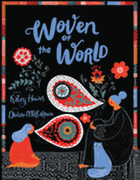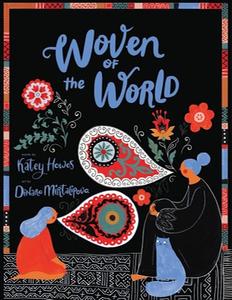
 Woven of the World is a splendid mosaic of a picture book, lyrically written by Katey Howes (Rissy No Kissies) and lushly illustrated by Dinara Mirtalipova (Russian Tales). "I listen, as I'm weaving,/ to the rhythm of the loom," Howes writes. "I imagine skeins of history/ unfurled across the room." She adroitly intertwines into her rhyming verses stories of "warm tradition" that cross borders and span years.
Woven of the World is a splendid mosaic of a picture book, lyrically written by Katey Howes (Rissy No Kissies) and lushly illustrated by Dinara Mirtalipova (Russian Tales). "I listen, as I'm weaving,/ to the rhythm of the loom," Howes writes. "I imagine skeins of history/ unfurled across the room." She adroitly intertwines into her rhyming verses stories of "warm tradition" that cross borders and span years.
Weaving, "in its many incarnations, may be the world's most ubiquitous art form." Nestled between the metrical refrain at the book's open and close--"Clack. Clack./ Swish--/ PULL BACK./ Bobbin and heddle,/ foot pedal, no slack"--is a collection of techniques passed down, preserved, adapted and dispersed through generations from across the globe. As Howes's narrative highlights practices and production, Mirtalipova enhances every page with her intricate, vibrant art.
In a spread at the book's start, "Silken threads/ coaxed from a white cocoon" are the tablecloth on a resplendent table set for tea. Steam rises from a pot and bowl, both of which are decorated with scenes of prepping, making and weaving inspired by ancient Chinese art styles. Mirtalipova, using a complementary palette of red, white, blue and black, adds a whimsical layer by turning the tabletop into a pastoral background of mountains, trees and a temple where the rising steam doubles as clouds. In Mirtalipova's gouache illustration is a clever reminder that weaving was historically a daily undertaking: while one tiny figure weaves the silk, another fishes and still another ferries a delivery. A kitty and woman peek over the table's edge, bearing witness to this creative past.
Throughout the book, women, children and cats function as multigenerational guides who demonstrate, display and share expertise. Howes thoughtfully chooses certain words as explicit signifiers for the areas of the world her history visits: "silken" and "dynasty" for ancient China; "flaxen" and "pharaoh" for ancient Egypt; "mountain villages" and "backstrap" for Indigenous Peru. Mirtalipova meticulously matches Howes's verses with carefully researched images, such as dancing women in traditional Peruvian clothing and headdresses, accompanied by gamboling, wool-supplying alpacas. Extensive back matter provides additional provenance and context. Author and artist intertwine their talents to gift "three dimensions of weaving" here: as practice, as art and, perhaps most importantly, as community creation. --Terry Hong, Smithsonian BookDragon
Shelf Talker: Author and illustrator highlight techniques and tools of weaving across centuries and cultures in this meticulously illustrated picture book presented in captivating rhythmic verse.

